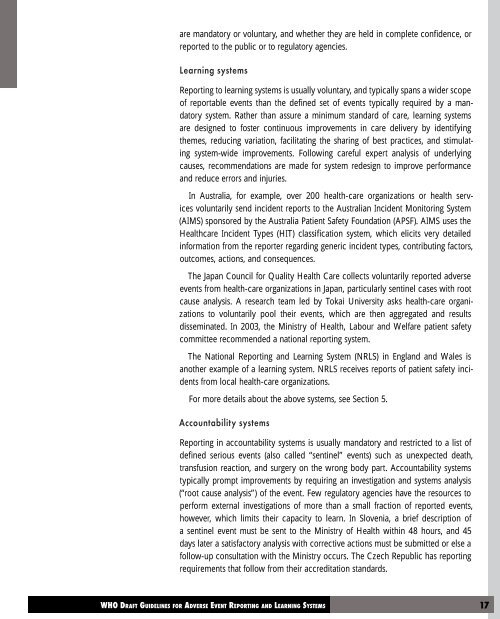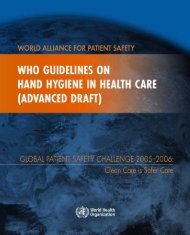Adverse event reporting.pdf
Adverse event reporting.pdf
Adverse event reporting.pdf
Create successful ePaper yourself
Turn your PDF publications into a flip-book with our unique Google optimized e-Paper software.
are mandatory or voluntary, and whether they are held in complete confidence, or<br />
reported to the public or to regulatory agencies.<br />
Learning systems<br />
Reporting to learning systems is usually voluntary, and typically spans a wider scope<br />
of reportable <strong>event</strong>s than the defined set of <strong>event</strong>s typically required by a mandatory<br />
system. Rather than assure a minimum standard of care, learning systems<br />
are designed to foster continuous improvements in care delivery by identifying<br />
themes, reducing variation, facilitating the sharing of best practices, and stimulating<br />
system-wide improvements. Following careful expert analysis of underlying<br />
causes, recommendations are made for system redesign to improve performance<br />
and reduce errors and injuries.<br />
In Australia, for example, over 200 health-care organizations or health services<br />
voluntarily send incident reports to the Australian Incident Monitoring System<br />
(AIMS) sponsored by the Australia Patient Safety Foundation (APSF). AIMS uses the<br />
Healthcare Incident Types (HIT) classification system, which elicits very detailed<br />
information from the reporter regarding generic incident types, contributing factors,<br />
outcomes, actions, and consequences.<br />
The Japan Council for Quality Health Care collects voluntarily reported adverse<br />
<strong>event</strong>s from health-care organizations in Japan, particularly sentinel cases with root<br />
cause analysis. A research team led by Tokai University asks health-care organizations<br />
to voluntarily pool their <strong>event</strong>s, which are then aggregated and results<br />
disseminated. In 2003, the Ministry of Health, Labour and Welfare patient safety<br />
committee recommended a national <strong>reporting</strong> system.<br />
The National Reporting and Learning System (NRLS) in England and Wales is<br />
another example of a learning system. NRLS receives reports of patient safety incidents<br />
from local health-care organizations.<br />
For more details about the above systems, see Section 5.<br />
Accountability systems<br />
Reporting in accountability systems is usually mandatory and restricted to a list of<br />
defined serious <strong>event</strong>s (also called “sentinel” <strong>event</strong>s) such as unexpected death,<br />
transfusion reaction, and surgery on the wrong body part. Accountability systems<br />
typically prompt improvements by requiring an investigation and systems analysis<br />
(“root cause analysis”) of the <strong>event</strong>. Few regulatory agencies have the resources to<br />
perform external investigations of more than a small fraction of reported <strong>event</strong>s,<br />
however, which limits their capacity to learn. In Slovenia, a brief description of<br />
a sentinel <strong>event</strong> must be sent to the Ministry of Health within 48 hours, and 45<br />
days later a satisfactory analysis with corrective actions must be submitted or else a<br />
follow-up consultation with the Ministry occurs. The Czech Republic has <strong>reporting</strong><br />
requirements that follow from their accreditation standards.
















